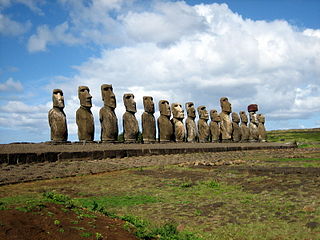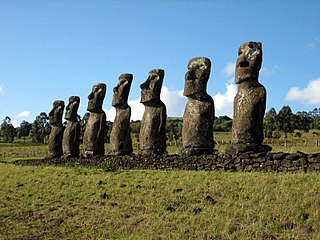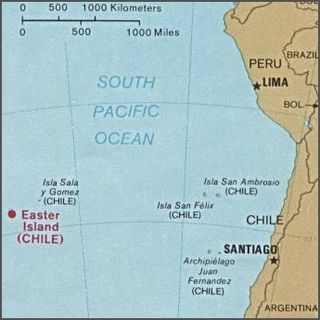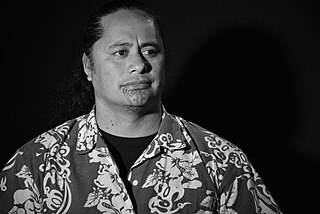Related Research Articles

Easter Island is an island and special territory of Chile in the southeastern Pacific Ocean, at the southeasternmost point of the Polynesian Triangle in Oceania. The island is most famous for its nearly 1,000 extant monumental statues, called moai, which were created by the early Rapa Nui people. In 1995, UNESCO named Easter Island a World Heritage Site, with much of the island protected within Rapa Nui National Park.

Haka are a variety of ceremonial dances in Māori culture. Haka are often performed by a group, with vigorous movements and stamping of the feet with rhythmically shouted accompaniment. Haka have been traditionally performed—by both men and women—for a variety of social functions within Māori culture. They are performed to welcome distinguished guests, or to acknowledge great achievements, occasions, or funerals.

Hanga Roa is the main town, harbour and seat of Easter Island, a municipality of Chile. It is located in the southern part of the island's west coast, in the lowlands between the extinct volcanoes of Terevaka and Rano Kau.

Moai or moʻai are monolithic human figures carved by the Rapa Nui people on Rapa Nui in eastern Polynesia between the years 1250 and 1500. Nearly half are still at Rano Raraku, the main moai quarry, but hundreds were transported from there and set on stone platforms called ahu around the island's perimeter. Almost all moai have overly large heads, which comprise three-eighths the size of the whole statue and they have no legs. The moai are chiefly the living faces of deified ancestors. The statues still gazed inland across their clan lands when Europeans first visited the island in 1722, but all of them had fallen by the latter part of the 19th century. The moai were toppled in the late 18th and early 19th centuries, possibly as a result of European contact or internecine tribal wars.

The Rapa Nui are the Polynesian peoples indigenous to Easter Island. The easternmost Polynesian culture, the descendants of the original people of Easter Island make up about 60% of the current Easter Island population and have a significant portion of their population residing in mainland Chile. They speak both the traditional Rapa Nui language and the primary language of Chile, Spanish. At the 2017 census there were 7,750 island inhabitants—almost all living in the village of Hanga Roa on the sheltered west coast.
Rapa Nui or Rapanui, also known as Pascuan or Pascuense, is an Eastern Polynesian language of the Austronesian language family. It is spoken on Easter Island, also known as Rapa Nui.

Rapa Nui National Park is a national park and UNESCO World Heritage Site located on Easter Island, Chile. Rapa Nui is the Polynesian name of Easter Island; its Spanish name is Isla de Pascua. The island is located in the southeastern Pacific Ocean, at the southeastern extremity of the Polynesian Triangle. The island was taken over by Chile in 1888. Its fame and World Heritage status arise from the 887 extant stone statues known by the name "moai", whose creation is attributed to the early Rapa Nui people who inhabited the island starting between 300 and 1200 AD. Much of the island has been declared as Rapa Nui National Park which, on 22 March 1996, UNESCO designated a World Heritage Site under cultural criteria (i), (iii), & (v). Rapa Nui National Park is now under the administrative control of the Ma´u Henua Polynesian Indigenous Community, which is the first autonomous institute on the island. The indigenous Rapa Nui people have regained authority over their ancestral lands and are in charge of the management, preservation and protection of their patrimony. On the first of December 2017, the ex-President Michelle Bachelet returned ancestral lands in the form of the Rapa Nui National Park to the indigenous people. For the first time in history, the revenue generated by the National Park is invested in the island and used to conserve the natural heritage.

Hoa Hakananai'a is a moai, a statue from Easter Island. It was taken from Orongo, Easter Island in 1868 by the crew of a British ship and is now in the British Museum in London.

Pedro Pablo Petero Edmunds Paoa is a Chilean politician. He serves as mayor of Rapa Nui Commune. He was previously the Governor of the Easter Island Province from March 2010 to August 2010.

Melania Carolina Hotu Hey is a Rapa Nui Chilean politician. She has served as the provincial governor of Easter Island, in Chilean Polynesia, in the first and second governments of Michelle Bachelet.

The flag of Easter Island is the flag of Easter Island, a special territory of Chile. It was first flown in public alongside the national flag on 9 May 2006.

Geologically one of the youngest inhabited territories on Earth, Easter Island, located in the mid-Pacific Ocean, was, for most of its history, one of the most isolated. Its inhabitants, the Rapa Nui, have endured famines, epidemics of disease, civil war, environmental collapse, slave raids, various colonial contacts, and have seen their population crash on more than one occasion. The ensuing cultural legacy has brought the island notoriety out of proportion to the number of its inhabitants.

The Father Sebastian Englert Anthropological Museum is a museum in the town of Hanga Roa on Rapa Nui in Chilean Polynesia. Named for the Bavarian missionary, Fr. Sebastian Englert, OFM Cap., the museum was founded in 1973 and is dedicated to the conservation of the Rapa Nui cultural patrimony.
The 2009 Copa Chile was the 30th edition of the competition. The competition started on May 10, 2009 with the preliminary round and concluded on November 15, 2009 with the Final. The winner qualifies for the 2010 Copa Sudamericana.

CF Rapa Nui is an association football team from Chile which represents the territory of Easter Island in association football. Their home games are played at the Estadio de Hanga Roa, which has a capacity of approximately 2,500 people.

Lynn Rapu Tuki, head-teacher and founder of the Ma'aranui Cultural Academy and the Cultural Ballet Kari Kari, is an active promoter of the arts and traditions of the Rapa Nui People. He is Cultural Ambassador of Asia-Pacific and has been Head of the Liaison Office of the National Council of Culture and the Arts.
Valentino Riroroko Tuki was a claimant to the Rapa Nui throne of Easter Island. He was the grandson of the last King Simeón Riro Kāinga, who died in 1899 and belonged to the Miru clan, descendents of the founder and first Ariki Mau of Rapa Nui, the legendary Hotu Matua.

As in other Polynesian islands, Rapa Nui tattooing had a fundamentally spiritual connotation. In some cases the tattoos were considered a receptor for divine strength or mana. They were manifestations of the Rapa Nui culture. Priests, warriors and chiefs had more tattoos than the rest of the population, as a symbol of their hierarchy. Both men and women were tattooed to represent their social class.

The COVID-19 pandemic was confirmed to have reached the Chilean island and special territory of Easter Island in March 2020.
References
- ↑ Hotel Tea Nui. "El Hoko, la danza de la fuerza y el respeto" (in Spanish). Retrieved 27 November 2014.
- ↑ rapanuirugby (6 August 2009). "Haka Rapanui Rugby". YouTube . Retrieved 17 September 2010.
- ↑ Ámbito.com (28 December 2009). "El 'Haka' de la Selección de Isla de Pascua de fútbol" (in Spanish). Retrieved 22 September 2015.
- ↑ Patricio Mena (6 August 2009). "Hoko de la Selección de Rapa Nui en la Moneda". YouTube . Retrieved 17 September 2015.